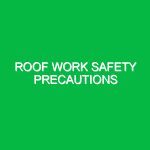Introduction to Safety Nets
Safety nets are critical components in the Health, Safety, and Environment (HSE) domain, designed to prevent accidents and mitigate risks in various work environments. Essentially, these nets serve as a safeguard against falls, providing a physical barrier that can protect workers engaged in high-risk activities such as construction, maintenance, and industrial operations. Their importance cannot be overstated; they are not merely precautionary measures, but vital tools that contribute significantly to workplace safety.
In the HSE context, safety nets are not just about preventing falls. They embody a broader philosophy of risk management and injury prevention. By creating a safety net—both literally and metaphorically—organizations strive to ensure that their employees can work in safer environments, ultimately fostering a culture of safety. The application of safety nets varies widely, from physical installations on construction sites to the implementation of safety protocols that serve as a safety net for employees’ well-being.
Identifying Hazards and Risks Associated with Safety Nets
While safety nets are designed to protect, they are not without their own risks. It’s crucial to recognize the potential hazards associated with their use. Firstly, the integrity of the safety net itself is paramount. A compromised net can lead to catastrophic failures. Factors such as wear and tear, exposure to harsh weather conditions, or improper installation can significantly diminish a safety net’s effectiveness.
Another risk involves the environment in which the net is deployed. For instance, if a safety net is placed in an area where heavy equipment operates or if it is not adequately secured, it can become dislodged, posing threats to workers below. Moreover, the positioning of safety nets often requires careful consideration of surrounding structures, which can introduce additional hazards. Workers may inadvertently become entangled in the net or fall into hazardous areas if the net is not appropriately designed and installed.
Additionally, the human factor plays a significant role in the effectiveness of safety nets. Training and awareness among personnel are crucial. If workers do not understand how to use safety nets properly, or if they neglect safety protocols, the risk of injury increases dramatically.
Best Practices and Safety Precautions for Using Safety Nets
Implementing safety nets effectively requires a comprehensive approach, involving planning, training, and ongoing maintenance. Here are some best practices to enhance safety when using safety nets in various applications:
1. Regular Inspections
Conduct routine inspections to ensure that safety nets are free from defects and wear. Look for fraying, tears, or any signs of damage. An anecdote from a construction site in Texas illustrates this point well. The team had a near-miss incident when a safety net that appeared intact failed during a routine operation. Post-incident investigations revealed that the net was over five years old and had not been inspected for wear. Regular inspections could have prevented this potentially dangerous situation.
2. Proper Installation
Ensure that safety nets are installed according to manufacturer guidelines and industry standards. This includes securing the net adequately to prevent it from shifting or collapsing under weight. Inadequate installation can lead to tragic falls, which can be easily avoided with proper training and adherence to safety protocols.
3. Training and Awareness
Training is crucial. Workers should be well-versed in the proper use of safety nets, including how to recognize hazards and how to respond in emergency situations. Conduct regular safety drills to reinforce this knowledge. A story from a manufacturing facility highlights the effectiveness of training: after implementing a comprehensive safety training program, the facility reported a 30% decrease in accidents related to falls.
4. Clear Communication
Establish clear communication protocols regarding safety net use. Workers should know who to report to in case of any issues, and there should be a clear understanding of the safety measures in place. This creates a culture of accountability and vigilance.
5. Adhere to Weight Limits
Every safety net has a specified weight limit. Exceeding this limit can lead to failure. Ensure all personnel are aware of these limits and monitor compliance.
Regulations and Standards Governing Safety Nets
In the realm of HSE, various regulations and standards govern the use of safety nets. These frameworks help ensure that safety measures are in place and adhered to, thereby safeguarding workers and minimizing risk. Some significant regulations include:
1. OSHA Regulations
The Occupational Safety and Health Administration (OSHA) establishes guidelines for safety nets in the workplace. OSHA Standard 1926.502 outlines requirements for the use of safety nets in construction. According to these standards, safety nets must be installed properly, be made of materials that can withstand potential forces, and be regularly inspected.
2. ANSI Standards
The American National Standards Institute (ANSI) also provides guidelines that complement OSHA regulations. ANSI A10.11 is particularly relevant, as it details the specifications for safety nets used in construction. Compliance with these standards ensures that safety nets meet specific performance criteria and safety levels.
3. Local Regulations
Apart from federal regulations, local safety codes may also apply. It is essential for organizations to familiarize themselves with regional regulations to ensure compliance and enhance safety measures.
Conclusion
Safety nets and their applications represent a critical aspect of workplace safety in the HSE domain. They serve not only as a physical barrier to prevent falls but also symbolize a commitment to employee safety and risk management. By understanding the hazards associated with safety nets, implementing best practices, and adhering to regulations, organizations can create safer working environments.
Safety nets are not just about compliance with regulations; they reflect an organization’s dedication to fostering a culture of safety. In an era where workplace safety is paramount, investing in proper safety net systems and protocols is a crucial step towards protecting the most valuable asset—our workforce.
As we approach safety from a holistic perspective, it becomes evident that the implementation of safety nets is a fundamental piece of the puzzle. By ensuring that these systems are effectively utilized, organizations can significantly reduce the risks associated with falls and injuries, ultimately creating a safer workplace for everyone involved.


